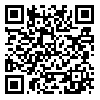BibTeX | RIS | EndNote | Medlars | ProCite | Reference Manager | RefWorks
Send citation to:
URL: http://jdisabilstud.org/article-1-2440-en.html
2- Associate Professor of Department of Educational Psychology, Allameh Tabataba'i University, Tehran, Iran
3- Associate Professor of Department of Clinical Psychology, Allameh Tabatabai University, Tehran, Iran
4- Assistant Professor of Department of Clinical Psychology, Science and Research Branch, Islamic Azad University, Tehran, Iran
Background & Objective: Behavioral activation and inhibition systems play a key role in regulating emotions, and a disorder in any of these systems can lead to disabilities in individuals. Also, these people are ready to grow and improve and expand their abilities, and they can establish sincere and reliable relationships with others. Behavioral activation and inhibition systems play an essential role in regulating emotions, and a disorder in each system can lead to disabilities in individuals. This study aimed to model flourishing based on the system of activation and behavioral inhibition mediated by dark personality in PhD students in the humanities.
Methods: The present study was a structural equation modeling. The study's statistical population included all PhD students in humanities (N=1621) studying at Islamic Azad University, Science and Research Branch of Tehran, in the academic year 2019–2020. Of whom, 770 volunteer students were recruited by the available sampling method. In this study, the following questionnaires were used to collect the required data. First, we used the behavioral activation and inhibition system questionnaire. This scale was developed by Carver and White (1994) and includes 20 self–reported questions. The behavioral inhibition subscale in this questionnaire consists of 7 items that measure the sensitivity of the behavioral inhibition system or response to the threat and the feeling of anxiety when faced with threatening symptoms. The behavioral activation subscale consists of 13 items and measures the sensitivity of the behavioral activation system personality questionnaire. This questionnaire was developed by Jones and Palhes (2014) and has 28 questions, and its purpose is to examine dark personality traits (narcissism, psychopath, Machiavelli). This questionnaire is based on the Likert scale. The flourishing questionnaire was developed by Soleimani et al. (2015) and has 28 questions. This questionnaire is scored on a 6–point Likert scale. The questionnaire has 4 sub–components: Positive emotions, relationships, meaning, and progress. In this study, we used mean and standard deviation in the descriptive findings section and the Kolmogorov–Smirnov test in the inferential findings section to check the normality of the data. The obtained data were analyzed using structural equation modeling at a significance level of 0.05 in SPSS version 24 and Amos version 22.
Results: Direct effects of behavioral inhibition system on dark personality (p=0.001, β=0.284), behavioral activation system on dark personality (p=0.008, β=–0.191), behavioral inhibition system on flowering (p=0.001, β=–0.351), behavioral activation system on flowering (p=0.001, β=0.603) and dark personality on flowering (p=0.001, β=–0.344) were significant. On the other hand, the indirect effects of the behavioral activation system on flowering mediated by dark personality (p=0.027, β=0.066) and the system of behavioral inhibition on flowering mediated by dark personality (p=0.003, β=–0.097) were significant. Also, the effects of the whole behavioral inhibition system on flowering (p=0.001, β=–0.445) and behavioral activation system on flowering (p=0.001, β= 0.669) were significant. On the other hand, the results showed that the effects of the whole behavioral inhibition system on flowering (p=0.001, β=–0.445) and the behavioral activation system on flowering (p=0.001, β=0.669) were significant. Also, the good fit indices indicated the proper fit of the model (χ2/df=2.98, AGFI=0.901, GFI=0.898, CFI=0.908, RMSEA=0.079).
Conclusion: Based on the results of this study, flourishing modeling based on the system of activation and behavioral inhibition mediated by dark personality is statistically significant, and the model has the necessary validity.
| Rights and permissions | |
 |
This work is licensed under a Creative Commons Attribution-NonCommercial 4.0 International License. |



